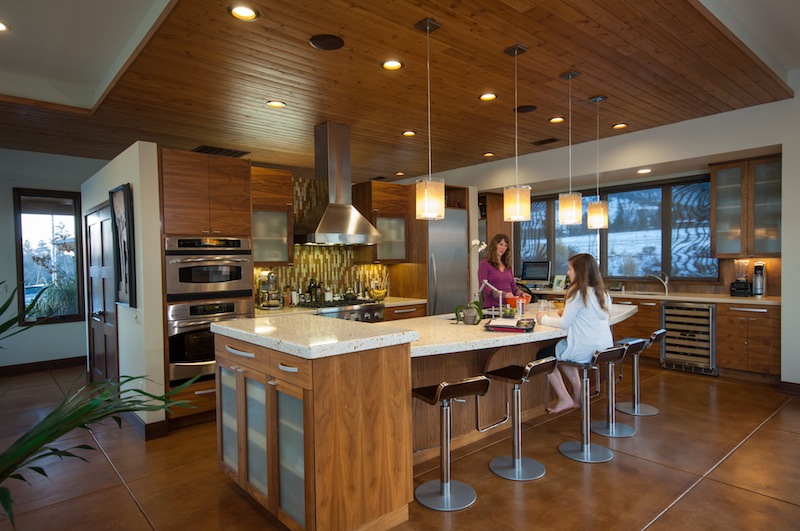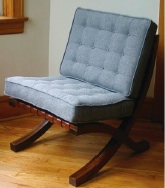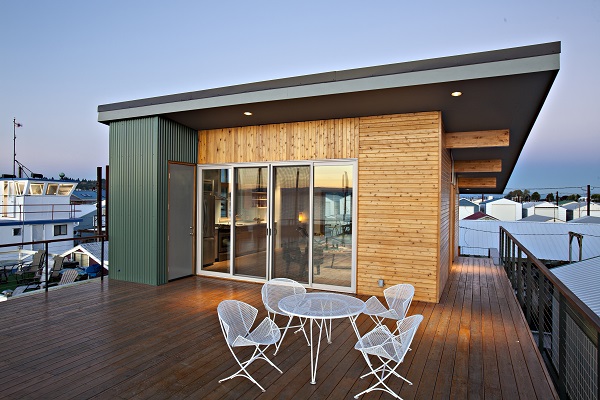Kitchen design is no longer limited to the clunky appliances and narrow footprints of yesteryear. Today, the kitchen is at the center of home life, and serves many functions—whether that’s cooking Sunday supper, entertaining friends, or spreading out the kids’ latest homework assignments. Here, two Oregon homeowners invest in convenience and style to make their kitchens the efficient—and attractive—centerpieces of their homes.

Bold and Sustainable in Ashland
Every morning, the Zeve family likes to eat a big breakfast together— usually managed by mom, Deneice Covert Zeve. But on a recent Friday, the family’s two pre-teen daughters took over and whipped up a batch of waffles before heading to school. Zeve, a former attorney, had hoped for just such an outcome when she designed the kitchen six years ago. “I wanted it to be a communal family space,” she says.
In 2007, when she and husband, Lincoln, set out to build on 9.5 acres in Ashland’s outskirts, they wanted a house that welcomed family and guests alike. Today, their solar home takes advantage of the sun exposure and panoramic mountain views. Nestled at its center is the kitchen. From it, Zeve can monitor the rest of the house—the entry, the pool and patio, even the kids’ play room at the end of a hall. More importantly, she says, “It’s like the heartbeat of the home.”
Having owned a French country-style home prior to building, Zeve, an avid baker, knew what she didn’t want—a cramped kitchen with scarce counter space. “But we didn’t want it to be too big either,” she says. The couple hired architect Carlos Delgado to strike the perfect balance and integrate the kitchen with the adjacent dining, living, and outdoor spaces. To achieve this, Delgado installed a large curved central island measured to Zeve’s reach, ideal for both rolling out dough and accommodating informal meals. The curve of the counter draws the eye to the spectacular views outside and provides a gentle transition into the next room.
The island also compels foot traffic along the room’s perimeter, allowing meal prep to be carried out with little interference. Along the window wall, a second prep station functions ideally for entertaining, complete with Vinotemp Wine Cooler, dishwasher and bar sink. On the island’s opposite side, a set of raised cabinets serve as a buffet for the informal dining room. The counter’s height obscures diners’ views of the countertop behind it. To accommodate the goods of marathon bake sessions and extra dough storage, a second oven and standing freezer are tucked into the passageway that leads to the day-lit pantry. Additionally, Zeve’s computer occupies an out-of-the-way corner to provide access to online recipes and doubles as a homework station for the girls.
To define the kitchen within the great room, Delgado dropped the ceiling and paneled it in Douglas fir. The natural, knotted appearance of the wood connects the space with the outdoors and establishes an earthy palette for the kitchen finishes. Warm walnut cabinetry, backsplash tiles in bronze and rust-colored glass, and a radiant concrete floor stained in a caramel-colored finish complete the scheme. For summer gatherings, Zeve throws open her French doors to the outdoor dining room so that the spaces—and guests— flow seamlessly throughout. She enjoys how the kitchen design enhances her family’s quality of life. With so much accessible lower storage, her girls can easily chip in with the chores. Further, she marvels at how much she’s grown as a cook, thanks to her kitchen’s design. “Having a kitchen like this, I want to be in it,” she says.
Modern Reinvention in Portland
When Liz Smith decided to move to Portland from Eugene, she wanted to find the ideal home for her new restaurant—that being Portland’s first Café Yumm! franchise. After a year of searching, a spot on the Portland State University campus proved perfect. It was several more months, however, before she found a 1967 mid-century modern house in the Southwest Hills that suited her own relocation. She was drawn to the house’s open floor plan, outdoor fireplace and clean interior lines. “But it was really a dump,” she says. An overgrown yard, popcorn ceilings and dated oak cabinets in the kitchen had her wondering whether the house could be the fresh start she sought. Having recently lost her husband of twenty-two years, Smith decided that overhauling the space was just the challenge she needed, so she bought it in 2010.
On the inventory of renovation to-dos, Smith listed the kitchen last, still seeking the right inspiration. She stumbled on it one summer day in the Pearl District. There, she glanced in a storefront and saw the exact countertop she wanted. Soon after, she called the creators of the counter, the firm Bright Designlab. Upon meeting with them, she had a plan —a contemporary, functional update to bring the kitchen into harmony with the house’s original era.
“We think of our kitchens as sculptures,” says Alissa Pulcrano, principal of Bright Designlab. To that end, they chose to retain the kitchen’s footprint but carve a new configuration for the upper and lower cabinets. A chunky white line frames the upper cabinets, then draws the eye down to a generous quartz countertop that extends into the adjacent dining area, to waterfall gracefully to the floor. The additional counter length adds storage space and provides Smith with a staging zone for entertaining.
The black-and-white palette, with ebonized oak and glossy white painted cabinets, is a nod to the house’s modern era. Pools of warmth form in organic materials—the dappled iris pattern in the tile backsplash, the island’s waterfall counter trimmed in Oregon black walnut, the salvaged end-grain fir floors and the battered brass pendants hanging over the island. Playful aspects include a shot of chartreuse color above the pantry and a chalkboard wall for Smith to post menus for holiday meals when her extended family visits.
Additional elements bring harmony to the kitchen and its surrounding living areas. The dark pantry wall draws attention away from the kitchen appliances and anchors an otherwise open space. An “appliance garage” resides in what often tends to be the kitchen’s “lost corner.” For it, an aluminum door rolls up to reveal a pull-out drawer with a toaster, which gets tucked away when not in use. The upper cabinets have sliding doors to conceal, or reveal, Smith’s glass and dishware collections.
Further tactful placements extend to her favorite mementos and personalize the space—an antique ship light from a Marseilles vacation with her husband, her greatgrandmother’s engraved martini mixer, a Thai sculpture from a trip with one of her daughters. Like her kitchen’s reincarnation, these details thoughtfully blend her past with the present.
Three Elements of a Cultivated Kitchen
LIGHTING
A dream scenario includes counter-to-ceiling windows. If this isn’t your reality, think layers. The overall light should be ambient—no blinding fluorescents. Specific tasks can be accomplished with targeted lighting. Under-cabinet, above-sink and colorful or architectural island pendants look best when mixed and matched for visual interest. This method is smart for tight budgets, as individual lights can often be found at thrift stores or a lighting shops’ cast-offs.
STAINLESS STEEL
The sleek, contemporary look of stainless steel looks great in many different elements of a kitchen. Appliances are the obvious stainless statement pieces, but there are a number of ways to tie in the industrial look throughout the space. A stainless steel stove hood or countertops are bold alternatives. For a smaller commitment, install a DIY backsplash with tin tiles. They are affordable and come in a stainless steel finish. You can also paint your way stainless with liquid stainless steel, transforming laminate countertops (or a number of other kitchen items) into stainless glossies in a weekend. Talk to your local hardware store about tin or liquid stainless steel options in your area. Both projects can be accomplished for less than $100 each.
COOKING INSPIRATION
Where do you store your favorite recipes? If the answer is in the depths of a drawer or the back of your mind, you need a change. The space above a kitchen sink is often wasted, though we stare at it daily while scrubbing dishes. Install a shelf or two, and display your cookbooks and recipe boxes, along with a statement art piece. Having them visible will inspire you to keep recipes organized and try new meal plans. Who knows, you may even crack open the “101 ways to cook veggies” cookbook you’ve been meaning to look at since you unwrapped it last holiday season.








